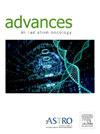不可切除腹膜后肉瘤中央增强放疗的疗效:一个病例系列。
IF 2.7
Q3 ONCOLOGY
引用次数: 0
摘要
目的:腹膜后肉瘤(RPS)的最佳治疗方法尚不明确。在这里,我们报告了在不可切除的RPS患者中使用高剂量增强辐射(3-4 Gy)到肿瘤中心部分的可行性。方法和材料:对5例不可切除的RPS患者采用中央增强技术加调强放射治疗。平均而言,25 Gy至45 Gy的剂量被递送到肿瘤的外部部分(计划靶体积1),而肿瘤的中心部分(计划靶体积2)接受了56 Gy至75 Gy的物理剂量,这相当于62.67 Gy至87.5 Gy的等效剂量,分为2 Gy的分数(EQD2)。为了尽量减少对邻近肠道和其他器官的辐射毒性,我们使用了顺序、交叉指间或同时集成增强(SIB)技术。结果:在这个RPS组织学变化的病例系列中,放射治疗后的中位生存期为30个月。在随访扫描中,5例患者中有3例局部疾病临床稳定,没有一例患者出现临床明显的毒性。结论:总之,在这个5例患者的小病例系列中,治疗耐受性良好,并且无论中心增强的时间如何,都观察到良好的局部反应。考虑到在有反应的患者中发生的高转移率,对不可切除的RPS进行肿瘤中心部位的积极放射治疗可能需要有效的全身治疗。本文章由计算机程序翻译,如有差异,请以英文原文为准。
Response to Central Boost Radiation Therapy in Unresectable Retroperitoneal Sarcoma: A Case Series
Purpose
Optimal treatment of retroperitoneal sarcoma (RPS) remains undefined. Here, we report the feasibility of using high-dose boost radiation (3-4 Gy) to the central part of the tumor in patients with unresectable RPS.
Methods and Materials
Five patients with unresectable RPS were treated with radiation therapy using a central boost technique with intensity modulated radiation therapy. On average, doses of 25 Gy to 45 Gy were delivered to the outer part of the tumor (planning target volume 1), while the central part of the tumor (planning target volume 2) received a 56 Gy to 75 Gy physical dose, which translates to a 62.67 Gy to 87.5 Gy equivalent dose in 2 Gy fractions (EQD2). To minimize radiation toxicity to the adjacent bowel and other organs, we used sequential, interdigitated, or simultaneous integrated boost (SIB) techniques.
Results
In this case series of variable RPS histology, the median survival postradiation therapy was 30 months. Three of the 5 patients had clinically stable local disease on follow-up scans, and none of the patients experienced clinically significant toxicity.
Conclusions
In summary, in this small case series of 5 patients, treatment was tolerated well, and excellent local responses were observed regardless of the timing of the central boost. Given the high rates of metastatic disease that developed in responding patients, effective systemic therapy will likely be needed for unresectable RPS treated with aggressive radiation therapy to the central part of the tumor.
求助全文
通过发布文献求助,成功后即可免费获取论文全文。
去求助
来源期刊

Advances in Radiation Oncology
Medicine-Radiology, Nuclear Medicine and Imaging
CiteScore
4.60
自引率
4.30%
发文量
208
审稿时长
98 days
期刊介绍:
The purpose of Advances is to provide information for clinicians who use radiation therapy by publishing: Clinical trial reports and reanalyses. Basic science original reports. Manuscripts examining health services research, comparative and cost effectiveness research, and systematic reviews. Case reports documenting unusual problems and solutions. High quality multi and single institutional series, as well as other novel retrospective hypothesis generating series. Timely critical reviews on important topics in radiation oncology, such as side effects. Articles reporting the natural history of disease and patterns of failure, particularly as they relate to treatment volume delineation. Articles on safety and quality in radiation therapy. Essays on clinical experience. Articles on practice transformation in radiation oncology, in particular: Aspects of health policy that may impact the future practice of radiation oncology. How information technology, such as data analytics and systems innovations, will change radiation oncology practice. Articles on imaging as they relate to radiation therapy treatment.
 求助内容:
求助内容: 应助结果提醒方式:
应助结果提醒方式:


